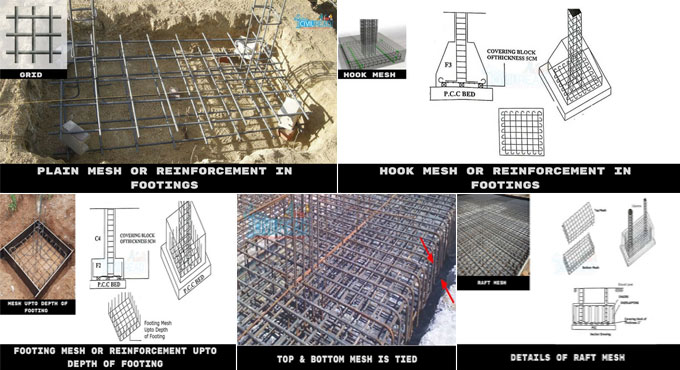
Common types of reinforcement or mesh utilized in several footings or foundations
Several types of Reinforcement are used in footings for tension requirements. The ratio of reinforcement in footings remains among 0.5% to 0.8%. Usually, the structural engineer design the type of mesh in footings on the basis of load analysis.
The following types of reinforcement are found in footings or foundations :?
1. Plain Mesh: This type of Mesh is normally provided in plain or isolated or combined footings and it is useful for low-rise buildings. Prior to use plain mesh, it is necessary to inspect the load based on this mesh and determine whether this type of mesh is able to combat the load or not.
Under this type, bars are arranged as a grid. It may contain bars with various diameters and spacing in either direction. The spacing may or may not varies in both directions.
2. Mesh with hooks (Hook Mesh): This type of mesh is suitable for low rise and high rise buildings. The footing is reinforced as grid and the bars are hooked at the ends of the mesh. Perfect anchorage of the reinforcement can be done by bending the bars ends. Here, the hook length is 9D and D stands for the diameter of the bar.
3. Footing Mesh up to the depth of Footing: It has similarity with plain footing. Under this type, the bars are bent at ends up to a height of footing. Here, the concrete cover of 1? to 4? is arranged in all the sides of footing.
4. Raft Mesh: This type of Mesh is ideal for raft footing. Raft footing can be used when soil bearing strength is very less. Under this type, Mesh is segregated into two parts as top mesh and bottom Mesh.
Initially, the bottom mesh is set on covering blocks, ends of a bottom mesh are bent at an angle of 90 degree up to a height of 50D where D means dia of bar. After that, the top mesh is connected with the bottom mesh in opposite direction. Besides, the top mesh is identical to bottom mesh bent with 90 degrees but an additional bar of 50D is not arranged since it is already provided on bottom mesh.
The 50D extra bar is arranged either on bottom or top mesh.
Both single ring and double ring are used in this type of mesh. The rings are attached with the top mesh and bottom mesh to retain the perfect framework. The Steel reinforcement is not deformed in any direction with the aid of rings. Minimum dia of bars for rings is 6 mm.
In single ring system, the rings are arranged in only one direction either horizontal or vertical, while in double ring system, the rings are arranged in both the direction.
Some vital points to rember :-
1. Concrete cover differs from 1? to 4? depending on size of the footing.
2. Hook length in Hook mesh always remains as 9D, where D means dia of bar.
3. Additional bar is arranged either on top or bottom mesh and the bar length is 50D..


